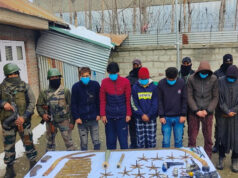MAKING WESTERN COAST FAIL SAFE NINE YEARS AFTER 26/11 ATTACK
By Colonel Awadhesh Kumar, Veteran Special Forces
The Coastal Security Bill to form a National Maritime Authority (NMA) is still entangled in the cobwebs of North Block and South Block in New Delhi. The National Committee for Strengthening Maritime and Coastal Security (NCSMCS) an ad-hoc arrangement at its best hobbles on its crutches. However as the ultimate agency at the cutting edge , Indian Navy along with the Indian Coast Guard cannot keep waiting for others . The Navy must move forward for a more secure future for India.
Nine years have elapsed since 26 November 2008 , the the 26/11 Mumbai carnage which had jolted the Country and made every one aware of the vulnerability of the Indian Sea Frontier. As things stand today whether Indian Coastal States are prepared to tackle another situation of that magnitude if it happens today — is still a Big No.
Presently India’s national coastal defence apparatus has a three-tier arrangement . In theory the Indian Navy, the Coast Guard, and the Coastal State’s marine police work in a coordinated manner to safeguard India’s maritime zones. However in practice there are huge gaps in spite
state-of-the-art harbour defence systems, multitude of coastal surveillance radars, high-power underwater sensors and diver detection sonars, capable of detecting, identifying, tracking and generating a warning for both surface and under water threats.
The waters extending up to the 12 nautical mile from the Coast , forming the second tier comes under the Coast Guard. The coastline and inland waters forms the third tier and is the responsibility of the concerned State Marine Police. The Coast Guard has augmented its air and surface fleet to a large extent by acquiring state of art weapons and equipment. The States too have enhanced their Marine Police’s budget with more funds for providing additional manpower, surveillance assets and speed boats. More coastal police stations are being set up, and radio frequency identity cards have been distributed to the fishermen.
The Indian Navy handles the task of protecting the outermost tier that is the blue waters of the Indian Ocean and the Arabian Sea and the Bay of Bengal. This capability is being enhanced day by day with commissioning of new Ships and submarines. We are already on our way to build a third Fleet to be located in Andaman. Action has also been initiated to build up our brown water capabilities too. To enhance the Coastal defences , Sagar Prahari Bal (Ocean Sentinels) has been established and are being equipped with high-speed intercept vehicles, helicopters and UAVs.
To check preparedness and synergy between all the security stakeholders, the Indian Navy conducts a six monthly exercise Sagar Kavach . It is a two sided exercise to test the efficacy of our coastal security system. However, while there have been significant augmentations to counter-terrorism capabilities, there are several crippling gaps that need to be filled to make Indian coast line and its cities safe and secure. The biggest problem lies with the States . There is rampant non or under-utilisation of funds , long delays in creation of shore-based infrastructure, human resources shortages, and plain red tape which plays crucial delaying role in creation of basic capacities.
The answer to these problems is that as the lead agency , the Indian Navy must create a new command and control organisation at Naval Command level and at Naval Area level. The process needs to commence with Western Naval Command and evolve progressively and thereafter cover other naval Commands. The Western Naval Command already has a FODAG
that is Flag Officer Defence Advisory Group in the rank of a Rear Admiral. He needs to be designated as Flag Officer Coastal Surveillance and Defence ( West). All naval ships and crafts presently allotted for defence of the Coastal waters should be placed under his command under a Commodore Coastal Squadron. Similarly three shore establishments need to be raised located one each in Gujarat Naval Area , Maharashtra Naval Area and Goa Naval Area cum NOIC Karnataka , under a Commodore each and designated as HQ Surveillance & Security Centres. These Centres will report to the FOCSD ( West) and will be responsible for all Coastal Surveillance Assets including all missile bases for air defence / anti missile / shore to ship .
HQ FOCSD will also be responsible for coordinating with the Naval Areas , Coast Guard in the region and with the Marine Police of the respective States. Naval Areas will be responsible all Coordination with their respective Coastal State.
Over a period of time , each Naval Area should have adequate number of patrol boats , fast crafts , hover crafts and Samudra Prahari Bal positioned at its logistic / forward operating bases for surveillance and security of coastal waters up to 24 km from the shore line. Forward operating bases need to come up in Gujarat Naval Area . The Western Fleet is itself expanding and therefore even before completion of Project Sea Bird , at least two Flotilla level bases must be recced and planned in Maharashtra/ Gujarat Naval Area. By then the Naval assets for defence of brown water should expand with an Rear Admiral in Command. The full fledged FOCSD ( West ) will need to be commanded by a Vice Admiral and the totally net centric and capable Surveillance Centres by Rear Admirals.
With expanding Chinese naval footprints in IOR coupled with presence of other extra regional naval powers and our evergreen Pakistan Navy apart from a full spectrum blue water fleet under the Western Naval Command India must immediately plug the existing loopholes in our Coastal Security system. Wherewithal are generally existing but with dynamic terror tactics our Command and Control system too must evolve with time to avoid becoming obsolete. The cost of inaction is something the Nation cannot not afford to pay.





